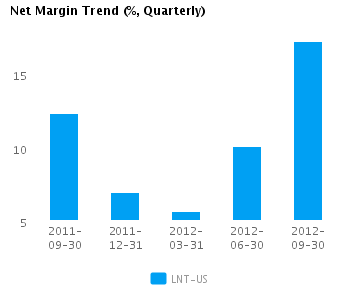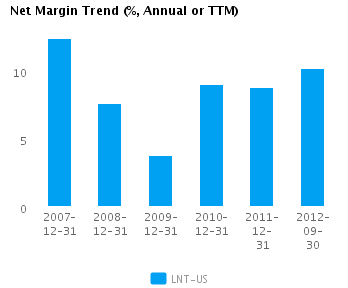
Alliant Energy Corp.’s analysis versus peers uses the following peer-set: Xcel Energy Inc (NYSE:XEL), Northeast Utilities System (NYSE:NU), DTE Energy Company (NYSE:DTE), Wisconsin Energy Corporation (NYSE:WEC), CMS Energy Corporation (NYSE:CMS), Integrys Energy Group, Inc. (NYSE:TEG), Westar Energy Inc (NYSE:WR), ALLETE Inc (NYSE:ALE) and MGE Energy, Inc. (NASDAQ:MGEE). The table below shows the preliminary results along with the recent trend for revenues, net income and returns.
| Quarterly (USD million) | 2012-09-30 | 2012-06-30 | 2012-03-31 | 2011-12-31 | 2011-09-30 |
|---|---|---|---|---|---|
| Revenues | 887.6 | 690.3 | 765.7 | 879.2 | 1,021.6 |
| Revenue Growth % | 28.6 | (9.8) | (12.9) | (13.9) | 24.7 |
| Net Income | 153.0 | 69.4 | 43.3 | 61.0 | 125.9 |
| Net Income Growth % | 120.5 | 60.3 | (29.0) | (51.5) | 127.7 |
| Net Margin % | 17.2 | 10.1 | 5.7 | 6.9 | 12.3 |
| ROE % (Annualized) | 20.0 | 8.7 | 5.2 | 7.6 | 16.5 |
| ROA % (Annualized) | 6.1 | 2.8 | 1.8 | 2.5 | 5.4 |
Valuation Drivers
Alliant Energy Corp.’s current Price/Book of 1.6 is about median in its peer group. The market expects LNT-US to grow at about the same rate as its chosen peers (PE of 15.7 compared to peer median of 16.0) and to maintain the peer median return (ROE of 10.7%) it currently generates.
The company’s asset efficiency (asset turns of 0.3x) and net profit margins of 10.1% are both median for its peer group. LNT-US’s net margin is greater than (but within one standard deviation of) its five-year average net margin of 8.3%.
Economic Moat
The company has achieved better revenues growth than its chosen peers (year-on-year change in revenues of 7.3%) but its earnings growth performance has been below the median (change in annual reported earnings of 4.1% compared to the peer median of 12.0%). This suggests that, compared to its peers, the company is focused more on top-line revenues. LNT-US is currently converting every 1% of change in revenue into 0.6% change in annual reported earnings.
LNT-US’s current return on assets is around peer median (3.3% vs. peer median 2.9%). This contrasts with its higher than peer median return on assets over the past five years (3.6% vs. peer median 2.7%), suggesting that the company’s relative operating performance has declined.
The company’s gross margin of 48.3% is around peer median suggesting that LNT-US’s operations do not benefit from any differentiating pricing advantage. In addition, LNT-US’s pre-tax margin of 12.4% is also around the peer median suggesting no operating cost advantage relative to peers.
Growth & Investment Strategy
While LNT-US’s revenues have grown faster than the peer median (-0.1% vs. -1.6% respectively for the past three years), the market gives the stock an about peer median PE ratio of 15.7. This suggests that the market has some questions about the company’s long-term strategy.
LNT-US’s annualized rate of change in capital of 6.1% over the past three years is greater than the peer median of 4.1%. However, this investment level has only generated a peer median return on capital of 4.4% averaged over the same three years. This median return on an above median capital investment suggests the company is overinvesting.
Earnings Quality
LNT-US’s net income margin for the last twelve months is around the peer median (10.1% vs. peer median of 9.1%). This average margin combined with a level of accruals that is around peer median (11.3% vs. peer median of 11.3%) suggests there possibly isn’t too much accrual movement flowing into the company’s reported earnings.
LNT-US’s accruals over the last twelve months are positive suggesting a buildup of reserves. However, this level of accruals is also around the peer median and suggests the company is recording a proper level of reserves compared to its peers.
Trend Charts






Company Profile
Disclaimer
This article was originally written by abha.dawesar, and posted on CapitalCube.




